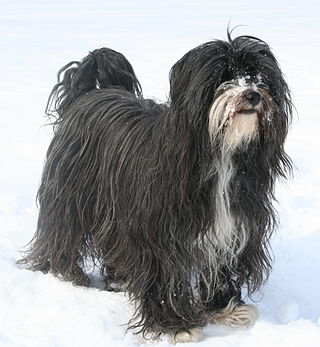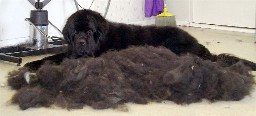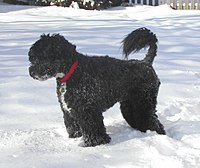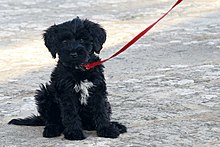
A Bichon Frisé is a small breed of dog of the bichon type.

The Chinese Crested Dog is a hairless breed of dog. Like most hairless dog breeds, the Chinese Crested Dog comes in two varieties, without hair and with hair, which can be born in the same litter: the hairless and the powderpuff.
Hypoallergenic, meaning "below average" or "slightly" allergenic, is a term meaning that something causes fewer allergic reactions. The term was first used in 1953 in an advertising campaign for cosmetics or perhaps as early as 1940. A 2017 study of the top-selling skin moisturizers from Amazon, Target, and Walmart found 83% of those marketed as "hypoallergenic" contained at least one potentially allergenic chemical.

The Goldendoodle, also known as a Groodle, is a designer dog created by crossbreeding a Golden Retriever and a Poodle. First widely bred in the 1990s, they are bred in three different sizes—each corresponding to the size of Poodle used as a parent.

A Labradoodle is a crossbreed dog created by crossing a Labrador Retriever and a Standard or Miniature Poodle. The term dates back to at least 1955 but was unpopular at the time. Labradoodles are, wrongfully so, considered a good choice for people with canine dander allergies, even though most dogs produced from this mix will shed. However, since a small number of the mixed breeds have the same or similar low shed coat of their poodle parents or grandparents, some people consider this mix a good choice.

The Poodle, called the Pudel in German and the Caniche in French, is a breed of water dog. The breed is divided into four varieties based on size, the Standard Poodle, Medium Poodle, Miniature Poodle and Toy Poodle, although the Medium Poodle is not universally recognised. They have a distinctive thick, curly coat that comes in many colors and patterns, with only solid colors recognized by breed registries. Poodles are active and intelligent, and are particularly able to learn from humans. Poodles tend to live 10–18 years, with smaller varieties tending to live longer than larger ones.

The Pembroke Welsh Corgi is a cattle herding dog breed that originated in Pembrokeshire, Wales. It is one of two breeds known as a Welsh Corgi, the other being the Cardigan Welsh Corgi. Pembroke Welsh Corgis descended from the Spitz family of dogs.

The Smooth Collie is a breed of dog developed originally for herding. It is a short-coated version of the Rough Collie of Lassie fame. Some breed organisations consider the smooth-coat and rough-coat dogs to be variations of the same breed.

The soft-coated Wheaten Terrier is a pure-breed terrier originating from Ireland. Wheatens typically have one of two coat types: Irish or Heavy (American). The Irish coat is generally silkier and wavier than the Heavy, or American coat, which is thicker and fuller. Wheatens are generally friendly and playful, and tend to get along well with children and other dogs.

The Havanese, a bichon-type dog, is the national dog of Cuba, developed from the now extinct Blanquito de la Habana. The Blanquito descended from the also now-extinct Bichón Tenerife. It is believed that the Blanquito was eventually cross-bred with other bichon types, including the poodle, to create what is now known as the Havanese. Sometimes referred to as "Havana Silk Dogs", but this is a separate breed, which has been bred to meet the original Cuban standards.

The Glen of Imaal Terrier is a breed of dog of the terrier category and one of four Irish terrier breeds. It is sometimes called the Irish Glen of Imaal Terrier or the Wicklow Terrier, and the name of the breed is often shortened by fanciers to just Glen.

The coat of the domestic dog refers to the hair that covers its body. Dogs demonstrate a wide range of coat colors, patterns, textures, and lengths.

The Tibetan Terrier is a medium-sized breed of dog that originated in Tibet. Despite its name, it is not a member of the terrier group. The breed was given its English name by European travelers due to its resemblance to known terrier breeds. The Tibetan name for the breed, Tsang Apso, roughly translates to "shaggy or bearded ("apso") dog, from the province of Tsang". Some old travelers' accounts refer to the dog as Dokhi Apso or "outdoor" Apso, indicating a shaggy or bearded working dog which lives outdoors.

The Löwchen or Little Lion Dog is a breed of small dog. The Löwchen once had the dubious distinction, like the Portuguese Water Dog and the Havanese, of being the rarest dog in the world. In 1973 there were only 65 registered examples of the breed. Even today, the breed generally has fewer than a few hundred new registrations each year worldwide.

The Coton de Tuléar is a breed of small dog named for the city of Tuléar in Madagascar. This breed is thought to have originated from a group of small white dogs that swam across the Malagasy channel following a shipwreck. Known for its cotton-like coat, the Coton de Tuléar typically grows to no more than 18 pounds (8.2 kg), and are white, sometimes with grey, tan, black, or tri-colored markings. The Coton de Tuléar Day is celebrated on November 26.

The Curly-coated Retriever is a breed of dog originally bred in England for upland bird and waterfowl hunting. It is the tallest of the retrievers and is easily distinguishable by the mass of tight curls covering its body. Curly Coated and Wavy Coated were the first two recognised retriever breeds, established as early as 1860.
Progressive retinal atrophy (PRA) is a group of genetic diseases seen in certain breeds of dogs and, more rarely, cats. Similar to retinitis pigmentosa in humans, it is characterized by the bilateral degeneration of the retina, causing progressive vision loss culminating in blindness. The condition in nearly all breeds is inherited as an autosomal recessive trait, with the exception of the Siberian Husky (inherited as an X chromosome linked trait) and the Bullmastiff (inherited as an autosomal dominant trait). There is no treatment.

The Spanish Water Dog breed is used in Spain as a general purpose sheepdog and guard. It is also used sometimes as a gundog, and is skilled at retrieval from water.

Dog grooming refers to both the hygienic care and cleaning of a dog, as well as a process by which a dog's physical appearance is enhanced for showing or other types of competition. A dog groomer is a person who earns their living grooming dogs.

Sunny is a pet dog of the Obama family, the 44th presidential family of the United States. Sunny is a female Portuguese Water Dog who was a First Dog of the United States along with Bo. Sunny was introduced via First Lady Michelle Obama's Twitter account on August 19, 2013.





























